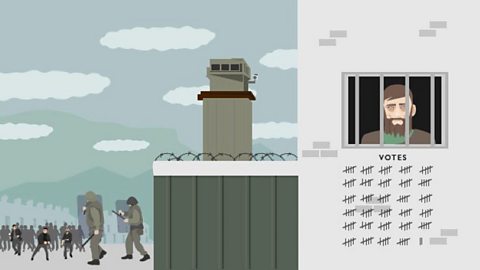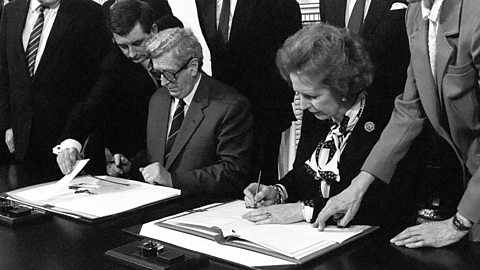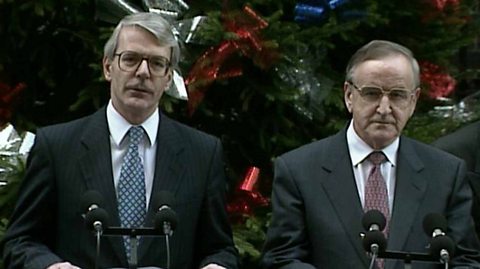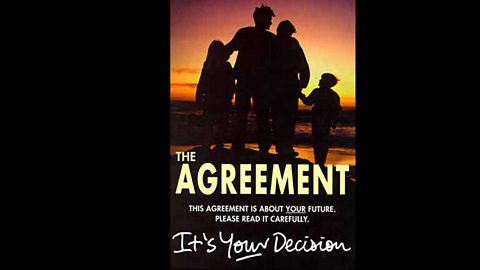A new government
Despite the extreme violence of 1972, it was not until March 1973 that the British government released proposals for the future of Northern Ireland.
The British Government decided to replace Stormont with a new assemblyAnother name for a parliament. and ExecutiveAnother name for the government or cabinet. The Executive is made up of the core group of politicians who carry out the major roles within the ruling government of a country..
There were a number of elements to this new system:
- Members of the Assembly would be elected using proportional representationAn electoral system in which parties gain seats in proportion to the number of votes cast for them..
- Members of the Executive would come from both unionistA person who believes the union between Britain and Northern Ireland should continue. and nationalistPeople who believe their country should be independent from other nations. For example, Irish nationalists, who want Ireland to be fully independent of Britain. parties.
- There would be an Irish Dimension in the form of a Council of Ireland that would allow politicians from North and South to meet and discuss issues relevant to both parts of the island.
In addition, London would retain control of security and justice.
Reaction
As usual, there were very different reactions to the British governmentÔÇÖs plans.
unionistA person who believes the union between Britain and Northern Ireland should continue. politicians were divided by the proposed solution:
- Former Prime Minister Brian Faulkner supported the plans and some of his party members agreed with his position.
- Many unionists ÔÇô including the rest of FaulknerÔÇÖs party, the Democratic Unionist Party (DUP)A conservative and unionist party in Northern Ireland, formed in 1971 by the Rev Ian Paisley. The party has strongly opposed any role for the Republic of Ireland in the governing of Northern Ireland. From 1971-1998, it opposed the 1973-1974 Power Sharing Assembly and Executive, the Anglo-Irish Agreement and the Good Friday Agreement. and the new Vanguard Unionist Progressive Party (set up by William Craig to oppose power-sharing) - were angry at the plans. These different groups came together to form the United Ulster Unionist Council (UUUC)An anti-power-sharing umbrella grouping composed of members of the Official Unionists, the DUP and the Vanguard Unionist Progressive Party, set up by William Craig to oppose power-sharing.. Their plan was to oppose the plans for power sharing and an Irish Dimension.
nationalistPeople who believe their country should be independent from other nations. For example, Irish nationalists, who want Ireland to be fully independent of Britain. politicians were generally happy with the plans for a power sharing Assembly and Executive.
Election results
The first elections for the new power sharing Assembly were held in June 1973.
The results were as follows:
| Party | Pro- or Anti- Power-sharing | Percentage of vote (%) | Number of seats won |
|---|---|---|---|
| Faulkner Unionists | Pro | 29.3 | 24 |
| UUUC Unionists | Anti | 32.1 | 26 |
| SDLP (Social Democratic and Labour Party) | Pro | 22.1 | 19 |
| APNI (Alliance Party of Northern Ireland) | Pro | 9.2 | 8 |
| NILP (Northern Ireland Labour Party) | Pro | 2.6 | 1 |
The results showed that:
- The parties in favour of power sharing had won the most seats.
- The number of unionistA person who believes the union between Britain and Northern Ireland should continue. elected who were against power sharing was greater than the number of unionists who supported power sharing.
The new Executive
In late November 1973, the Secretary of StateA politician who is in charge of a government department and who is usually a member of the Cabinet. for Northern Ireland, William Whitelaw, announced the make-up of the new power sharing ExecutiveAnother name for the government or cabinet. The Executive is made up of the core group of politicians who carry out the major roles within the ruling government of a country..
The Chief Executive was to be Brian Faulkner; his Deputy was to be Social Democratic and Labour Party (SDLP)An Irish nationalist party in Northern Ireland. When it was set up in August 1970, the SDLP was moderately left wing on social and economic issues. At the same time, the party sought political reforms within Northern Ireland and the eventual re-unification of Ireland. Leader Gerry Fitt.
The numbers of ministries to be held by the different parties were as follows:
| Unionists | Six ministries |
| SDLP | Four ministries |
| Alliance party | One ministry |
The Executive was also to have an additional four members but they would not have the right to vote.
Two of these non-voting members were to be from the SDLP, one from the Faulkner unionistA person who believes the union between Britain and Northern Ireland should continue. and one Alliance Party of Northern Ireland (APNI)A liberal, centre ground political party in Northern Ireland. Although broadly unionist when it was founded in April 1970, its MLAs designated as ÔÇÿOtherÔÇÖ in the Northern Ireland Assembly rather than ÔÇÿUnionistÔÇÖ or ÔÇÿNationalistÔÇÖ. member.
The 'Irish Dimension'
With the plans for power-sharing in place, attention turned to the Irish Dimension.
Northern IrelandÔÇÖs political leaders joined with leading politicians from Britain and Ireland at Sunningdale in England to work out their plans.
At first, Ian Paisley and William Craig, the leaders of the anti-power sharing unionists, were not invited to attend although at one point they were invited to join the conference.
Both men refused.
On 9 December 1973, the Sunningdale Agreement was signed.
It set out plans for the creation of a two part Council of Ireland:
- A 14-member Council of Ministers (seven from the power-sharing Executive, seven from the Irish Government). The Council would help develop North-South co-operation and would eventually be given decision-making powers.
- A 60-member Consultative assemblyAnother name for a parliament. (30 from the power sharing Assembly, 30 from Â┘├í¥▒▒¶The lower house in the Irish parliament. ). It was to have ÔÇÿadvisory and review functionsÔÇÖ only.
In addition:
- The British Government agreed not to oppose Irish unification if a majority of the people of Northern Ireland wanted it.
- The Irish Government accepted that Irish unity could only ever be achieved peacefully and with the consentApproval or agreement, particularly after thoughtful consideration. of the majority of the people of the North.
- At some future date, control over internal security issues would be returned to the Stormont Assembly.
- Approval of the decisions made at Sunningdale was to take place at a future conference.
Problems for the future
The Sunningdale Agreement looked like a real breakthrough; however, it soon became clear that unionistA person who believes the union between Britain and Northern Ireland should continue. and nationalistPeople who believe their country should be independent from other nations. For example, Irish nationalists, who want Ireland to be fully independent of Britain. leaders believed that they had agreed to different things:
- Brian Faulkner did not believe the Sunningdale Agreement was very important or had changed very much. He later explained that he had only agreed to sign it to get the Irish Government to accept that Northern Ireland was part of the UK.
- The Social Democratic and Labour Party (SDLP)An Irish nationalist party in Northern Ireland. When it was set up in August 1970, the SDLP was moderately left wing on social and economic issues. At the same time, the party sought political reforms within Northern Ireland and the eventual re-unification of Ireland. believed that the Agreement would be a major part in helping to create much closer ties between Northern Ireland and the Irish Republic.
Sunningdale was opposed by paramilitaryA person or organisation that operates like a military force, but is not part of a country's official armed forces. from both sides too:
- The day after the Sunningdale Agreement was signed, loyalistA person who, in terms of culture, identity and politics, retains a strong loyalty to Britain and firmly opposes a united Ireland. announced that they were setting up an Ulster Army Council. It would resist any significant ÔÇÿIrish DimensionÔÇÖ.
- The Provisional Irish Republican Army (PIRA)Irish republican paramilitary group formed when members split from the Official IRA (OIRA) in 1969. showed its disapproval by exploding a number of bombs in London just before Christmas.
The Executive takes power
On 1 January 1974, the ExecutiveAnother name for the government or cabinet. The Executive is made up of the core group of politicians who carry out the major roles within the ruling government of a country. and assemblyAnother name for a parliament. took power.
However, before long, the future of power sharing looked bleak.
This was because:
- On 4 January, the ruling committee of the Ulster unionistA person who believes the union between Britain and Northern Ireland should continue. Party voted to reject the Sunningdale Agreement. In response, Brian Faulkner resigned as leader of the Party; 19 of the 21 Ulster Unionist Assembly members resigned with him.
- At the end of February 1974, a General Election for the WestminsterThe London location of the British government. Parliament was held. All but one of the seats in Northern Ireland was won by United Ulster Unionist Council (UUUC)An anti-power-sharing umbrella grouping composed of members of the Official Unionists, the DUP and the Vanguard Unionist Progressive Party, set up by William Craig to oppose power-sharing. MPs who opposed power sharing.
The General Election also resulted in a change in government in London, with Labour returning to power under Harold Wilson.
The UWC strike
Despite calls for its removal, the power sharing ExecutiveAnother name for the government or cabinet. The Executive is made up of the core group of politicians who carry out the major roles within the ruling government of a country. and assemblyAnother name for a parliament. worked on.
As a result, anti-power sharing unionistA person who believes the union between Britain and Northern Ireland should continue. politicians, trade unionistA member of a trade union, which is an organisation of workers formed to protect the rights of its members. A trade union might argue for better wages or working conditions. and paramilitaryA person or organisation that operates like a military force, but is not part of a country's official armed forces. decided to set up the Ulster WorkersÔÇÖ Council (UWC).
On 14 May, the UWC began a general strikeWhen workers from lots of different industries all refuse to work to try and make a change.as a way of bringing the power sharing government down.
At first, the strike looked as if it might not be getting much support.
This changed, however, as a result of:
- The Ulster Defence Association (UDA)Formed in September 1971, it was active during the Northern Ireland 'Troubles' as a loyalist paramilitary group. It would often carry out attacks using the cover name Ulster Freedom Fighters (UFF). stopping people from going to work (using roadblocks and intimidationBehaviour that threatens an individual or group.).
- Improved co-ordination by the UWC.
By the end of the week, Northern Ireland was more or less shut down.
Only 200 people turned up to support a back to work demonstration.
Tensions across Northern Ireland were further increased on 17 May 1974 when bombs ÔÇô believed to have been planted by loyalist paramilitaries - exploded in Dublin and Monaghan.
27 people died immediately while five of the injured died later of their wounds.
The end of the strike
- By the middle of 1974, 17,500 soldiers were based in Northern Ireland. Despite its strength, the Army was reluctant to use force to end the strike, arguing that it was a political protest and not a terrorist action.
- Harold Wilson, the British Prime Minister, was rapidly losing patience with the strike; he showed his anger in a television speech on 25 May in which he condemned the Ulster Workers' CouncilA loyalist workers' organisation set up in Northern Ireland in 1974. It played a key role, alongside loyalist paramilitaries, in the strike which brought down the 1973-1974 power-sharing government. actions and described those involved in the strike as ÔÇ╚┘▒Þ┤Ã▓È▓Á▒░¨▓§ÔÇÖ.
- Northern IrelandÔÇÖs unionistA person who believes the union between Britain and Northern Ireland should continue. population saw WilsonÔÇÖs words as an attack on everyone, rather than just a condemnation of the UWC. As a result, support for the strike increased.
- Realising this, the British Government ordered the Army to take control of Northern IrelandÔÇÖs fuel supplies so that petrol would be available for ÔÇÿessential workersÔÇÖ.
- The UWC responded by ordering its supporters to bring Northern Ireland to a complete shutdown.
- On 28 May 1974, Faulkner resigned his post; the other unionists in the ExecutiveAnother name for the government or cabinet. The Executive is made up of the core group of politicians who carry out the major roles within the ruling government of a country. did the same. He did this because of the refusal of the British Government (and the Social Democratic and Labour Party (SDLP)An Irish nationalist party in Northern Ireland. When it was set up in August 1970, the SDLP was moderately left wing on social and economic issues. At the same time, the party sought political reforms within Northern Ireland and the eventual re-unification of Ireland. ) to negotiate with the ▒½░┬░õÔÇÖs leaders. As a result, power-sharing ended.
- On 29 May 1974, the UWC declared its strike was over; the next day, the power-sharing Assembly was suspended and Direct Rule re-introduced.
For more information, including archive clips, on this subject, visit ┤¾¤¾┤½├¢: Ten Chapters of the Northern Ireland Troubles ()
WATCH: Power-sharing in Northern Ireland 1973-1974
Test your knowledge
More on Changing relations: Northern Ireland and its neighbours, 1965-98
Find out more by working through a topic
- count8 of 11

- count9 of 11

- count10 of 11

- count11 of 11
